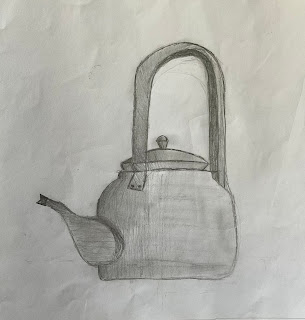Pencil Sketch of Drawings– Simplicity in Shadows
How to Draw Shadows of Objects (Pencil Sketching)
1. Identify the Light Source
Decide where the light is coming from — left, right, top, etc. This will affect the direction, length, and darkness of the shadow.
2. Draw the Object First
Sketch the main object carefully. Ensure the shapes and proportions are clear before you add shadows.
3. Determine the Shadow Shape
Imagine how the object blocks light. The shadow is basically a silhouette of the object, distorted by the surface it lands on and the angle of the light.
Keep the shadow connected to the object.
Shadows are usually longer when the light is low (sunset/sunrise) and shorter when it's overhead.
4. Start with Light Shading
Use soft strokes to mark the base of the shadow. Don’t go too dark at first — build it up gradually.
5. Darken the Core Shadow
There are usually two parts to a shadow:
Core shadow (the darkest part, right next to the object)
Cast shadow (fades out as it moves away)
Use an HB or 2B pencil for base shading, and 4B or 6B for the darkest areas.
6. Blend the Shadow
Use:
A blending stump
Your finger
A soft tissue
This softens harsh pencil lines and gives a realistic, gradient shadow effect.
7. Add Reflective Light (Optional)
Sometimes, a bit of light bounces back from nearby surfaces. You can leave a thin light line between the object and the shadow to show this — it adds realism
This artwork is a monochrome pencil sketch that captures the essence of a classic kettle, commonly used in many households. Done entirely in graphite pencil, the drawing demonstrates careful attention to:
-
Form and Proportion: The artist has maintained balanced proportions, particularly the curved spout, the round body, and the high arching handle.
-
Shading and Depth: Notice how the use of light and dark pencil strokes creates a sense of depth and dimension, especially around the kettle's belly and handle. The shadows give the object a realistic metallic feel.
-
Line Work: The outlines are soft yet confident, giving structure without overpowering the shading.
-
Minimalist Style: There's no background or color—just raw pencil on paper—which draws focus entirely to the object.
This kind of artwork is a great exercise in observation and rendering. It shows how even simple household objects can become beautiful subjects in art when you focus on detail and tone.






No comments:
Post a Comment